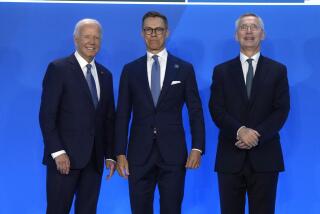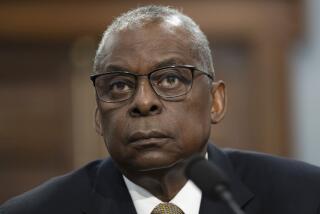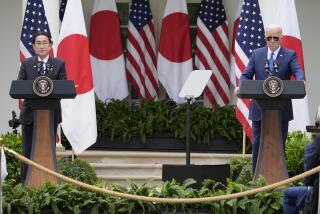U.S., Japan Sign Updated Set of Defense Guidelines
- Share via
UNITED NATIONS — The United States and Japan signed new defense guidelines Tuesday intended to update their alliance to meet the challenges of the post-Cold War world.
Although the revised procedures have generated concern in China, South Korea and other Asian countries, U.S. and Japanese officials said the guidelines do not threaten any other nation and do not change the pacifist Japanese Constitution drafted by the United States after World War II.
At the same time, the agreement requires the United States to maintain its military capability in Asia well into the next century.
“In order to meet its commitments, the United States will maintain its nuclear deterrent capability, its forward deployed forces in the Asia Pacific region and other forces capable of reinforcing those forward deployed forces,” according to the text of the agreement.
Like the 1978 guidelines being superseded, the new pact is essentially a one-way street. It establishes procedures for the United States to respond to an attack on Japan but, unlike the mutual defense requirements of the North Atlantic Treaty Organization and most other alliances, does not oblige Japan to come to the defense of American forces if the United States is attacked.
“It is not a new alliance. It is an old alliance that we are working to update,” one Clinton administration official said.
The revisions, drafted during more than a year of negotiations, were signed by Secretary of State Madeleine Albright, Defense Secretary William S. Cohen, Japanese Foreign Minister Keizo Obuchi and Japan Defense Agency chief Fumio Kyuma during their annual defense consultation in conjunction with the opening of the U.N. General Assembly.
Cohen said the pact establishes procedures for cooperation on handling refugees, peacekeeping duties, search and rescue operations, evacuation of civilians from areas of potential conflict, and other quasi-military tasks that were not front-burner issues when the previous guidelines were adopted.
U.S. officials said the primary purpose of the agreement is to establish procedures for U.S. assistance to Tokyo’s military forces in case Japan comes under threat or attack. Under the guidelines, the Japanese military is assigned the primary responsibility for responding to an attack on Japan.
Unlike the previous guidelines, which clearly were focused on possible aggression from the Soviet Union, the new pact is careful to avoid any suggestion of where an attack might originate.
Nevertheless, Obuchi conceded that his government has been unable so far to convince Beijing that the long-anticipated pact poses no danger to China. Albright insisted that the guidelines are not “country-specific or geographically specific” and do not change Washington’s policy toward China.
Later in the day, Albright met with Chinese Foreign Minister Qian Qichen. Talking to reporters before the meeting, Qian said, “The position of the Chinese side has been made clear” concerning its objections to the U.S.-Japan guidelines.
More to Read
Sign up for Essential California
The most important California stories and recommendations in your inbox every morning.
You may occasionally receive promotional content from the Los Angeles Times.










